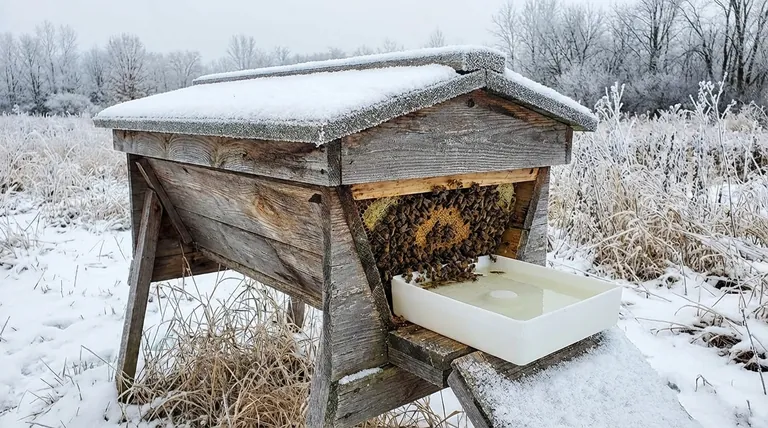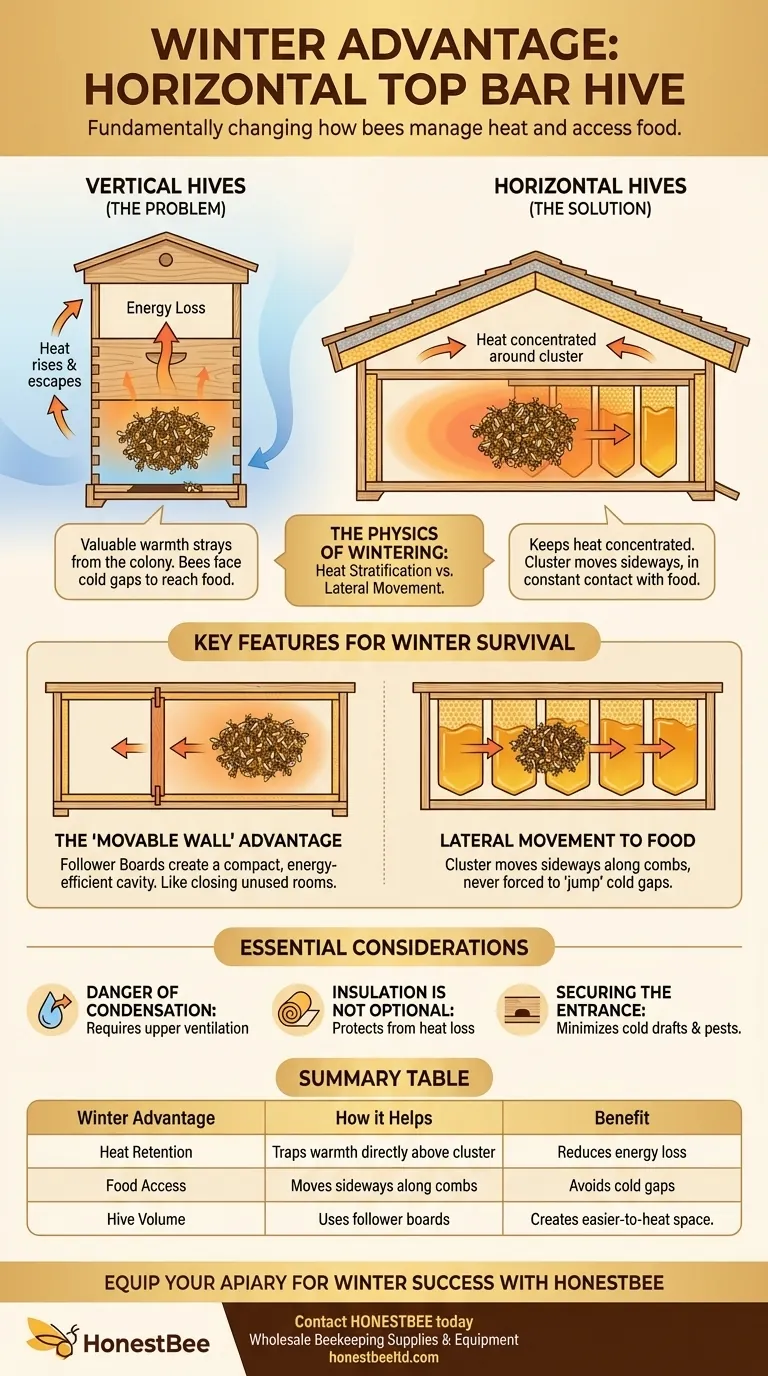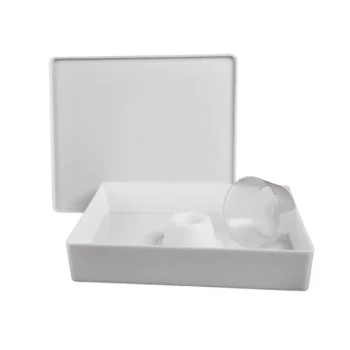The primary winter advantage of a top bar hive is its horizontal design, which fundamentally changes how bees manage heat and access food. Unlike vertical hives where valuable warmth rises and escapes, the long, low-profile cavity of a top bar hive keeps heat concentrated around the cluster. This allows the colony to move sideways into its honey stores, conserving critical energy needed for survival.
In contrast to a vertical hive where heat stratifies and rises away from the colony, a horizontal hive allows the beekeeper to create a compact, energy-efficient winter cavity. The bee cluster moves laterally, staying in constant contact with both its heat and its food source.

The Physics of Wintering: Horizontal vs. Vertical
A hive's shape directly impacts a colony's ability to thermoregulate. The difference between a tall, vertical hive and a long, horizontal one is a matter of basic physics with significant consequences for the bees.
The Problem with Vertical Space
In a standard vertical hive, heat generated by the winter cluster naturally rises. This warmth often collects in empty upper boxes, far from the bees that produced it, representing a massive and continuous energy loss.
How Horizontal Design Retains Heat
In a horizontal top bar hive, the heat also rises but is trapped against the insulated roof directly above the cluster. The cavity is long, not tall, so the heat remains concentrated in the immediate vicinity of the bees, drastically reducing the energy they must expend to stay warm.
The 'Movable Wall' Advantage
Top bar hives use follower boards, which are essentially blank boards that function as movable internal walls. As the colony shrinks for winter, the beekeeper can slide a follower board to reduce the hive's internal volume.
This creates a smaller, custom-fit space that is far easier for the bees to heat, much like closing off unused rooms in a house during winter.
Managing the Winter Cluster's Journey
The horizontal layout doesn't just help with heat; it also dictates how the colony accesses its winter food stores.
Lateral Movement to Food
The winter cluster is organized at one end of the hive, next to the consolidated honeycombs. As winter progresses, the entire cluster slowly moves sideways along the combs, consuming honey as it goes.
This lateral journey keeps the colony in a tight, cohesive ball. They are never forced to "jump" a cold, empty gap between boxes to reach more food, a common point of failure in vertical hives.
Consolidating Resources
Preparing for this journey is straightforward. The beekeeper simply arranges the full honeycombs adjacent to where the cluster will form its brood nest. This creates an uninterrupted path of food for the colony to follow through the coldest months.
Common Pitfalls and Essential Considerations
The horizontal design offers a powerful advantage, but it is not a complete solution on its own. Success requires attention to other critical factors.
The Danger of Condensation
All hives, regardless of shape, produce moisture from the bees' respiration. In a well-insulated hive, this warm, moist air can condense on cold surfaces and drip back down as freezing water.
A small amount of upper ventilation is crucial to allow this moist air to escape, keeping the bees dry and warm.
Insulation is Not Optional
The hive's design helps manage heat, but good insulation prevents it from being lost to the outside environment. An insulated top or a full hive wrap protects the colony from heat loss and shields it from cold winter winds.
Securing the Entrance
A reduced hive entrance is a universal best practice for winter. It minimizes cold drafts entering the hive and makes it easier for the colony to defend against pests seeking warmth and food.
Making the Right Choice for Your Goal
By understanding these principles, you can tailor your management of a top bar hive to maximize winter survival.
- If your primary focus is simplified management: The follower board system offers an intuitive way to adjust hive volume without lifting heavy boxes.
- If your primary focus is thermal efficiency: Combine the horizontal design with top insulation and a windbreak to create an exceptionally stable microclimate.
- If your primary focus is supporting natural bee behavior: The lateral movement of the cluster along its combs closely mirrors how bees would progress through food stores in a natural log hive.
Leveraging the unique architecture of a top bar hive empowers you to create a system that works with the bees' natural instincts for winter survival.
Summary Table:
| Winter Advantage | How a Horizontal Top Bar Hive Helps |
|---|---|
| Heat Retention | Traps warmth directly above the bee cluster, reducing energy loss. |
| Food Access | Allows the cluster to move sideways along combs, avoiding cold gaps. |
| Hive Volume Management | Uses follower boards to create a smaller, easier-to-heat space. |
Equip Your Apiary for Winter Success with HONESTBEE
Ready to leverage the winter advantages of a top bar hive design for your commercial operation? HONESTBEE supplies durable, high-quality beekeeping supplies and equipment to commercial apiaries and distributors through our wholesale-focused operations. From top bar hive components to essential wintering supplies like insulation and ventilation aids, we provide the reliable equipment you need to support strong, healthy colonies year-round.
Contact HONESTBEE today to discuss your wholesale needs and ensure your bees have the best chance of surviving the cold.
Visual Guide

Related Products
- HONESTBEE Professional Hive Top Bee Feeder Feeding Solution
- HONESTBEE Professional Long Handled Hive Tool with Precision Cutting Blade
- HONESTBEE Advanced Ergonomic Stainless Steel Hive Tool for Beekeeping
- Professional Hive Top Bee Feeder for Beekeeping
- Professional Engraved Round Hive Number Tags for Beekeeping
People Also Ask
- What should be done with feeders and equipment after feeding bees? Essential Steps for Apiary Health
- What is a top feeder for bees? Maximize Colony Health with Efficient Feeding
- How is the plywood floor fitted into the hive-top feeder? Ensure Longevity with a Floating Floor Design
- How do I keep bees from drowning in my top feeder? Ensure Safe Feeding for Your Hive
- What are the advantages of hive top feeders? Maximize Feeding Efficiency for Your Apiary



















